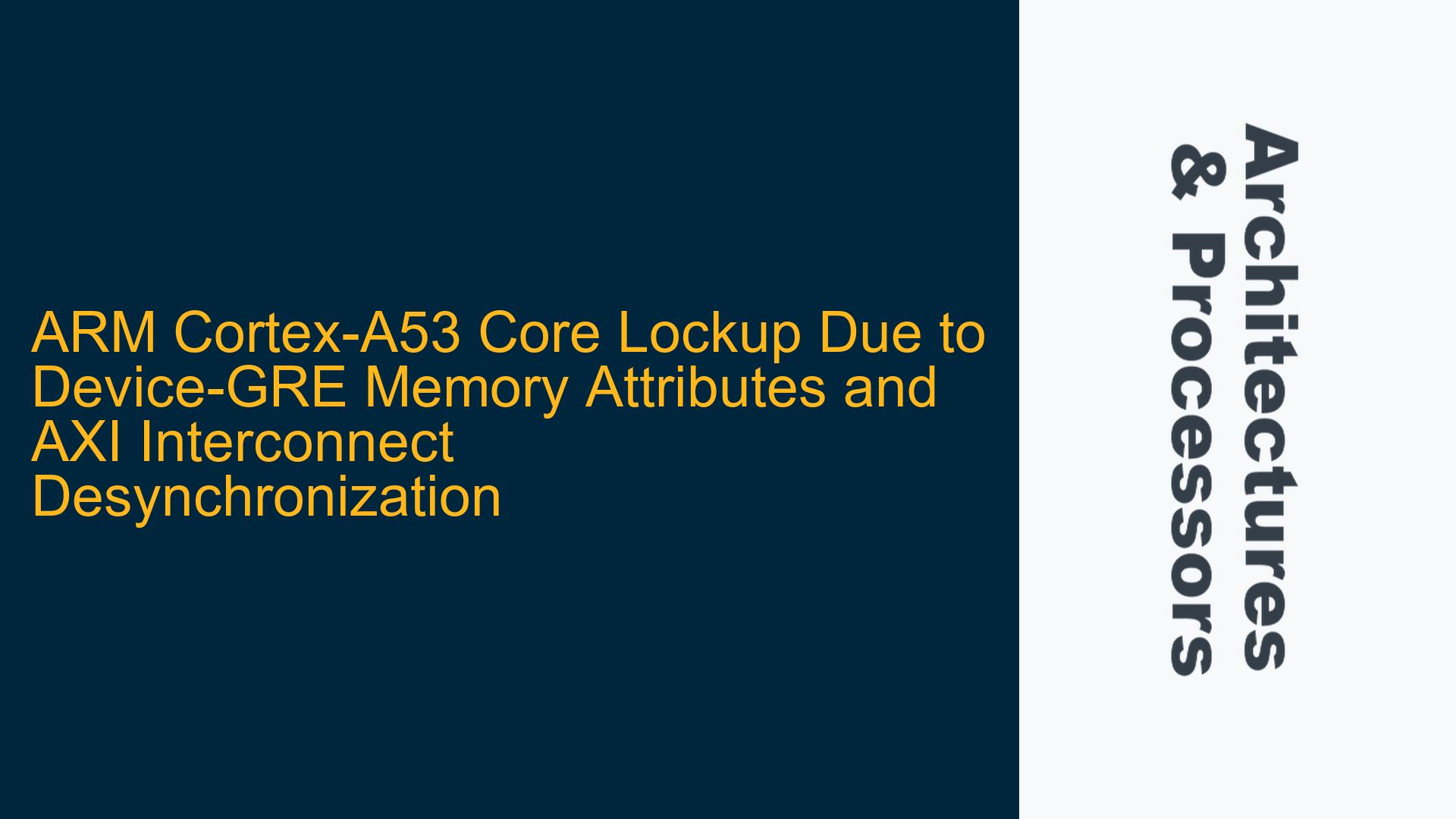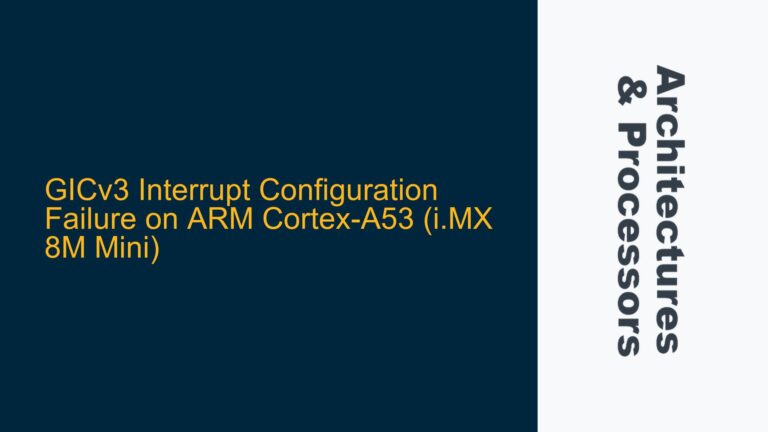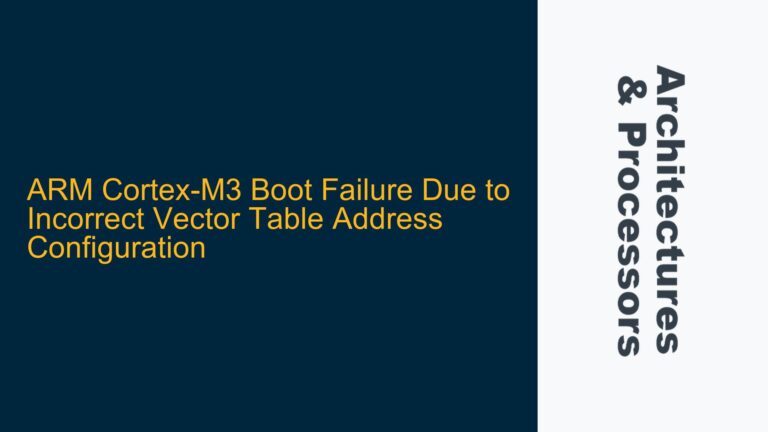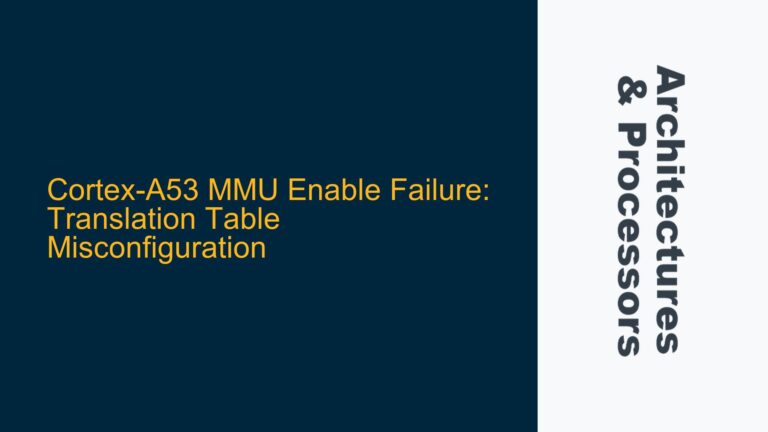ARM Cortex-A53 Core Lockup During FPGA Memory Writes with Device-GRE Attributes
The ARM Cortex-A53 core, when configured to use Device-GRE (Gathering, Reordering, Early Write Acknowledgment) memory attributes for FPGA memory accesses, can experience core lockups and interconnect desynchronization. This issue arises when the A53 core attempts to combine multiple writes into larger AXI transactions to improve performance, but the FPGA fabric or AXI interconnect fails to handle the reordered or gathered transactions correctly. The problem manifests as incomplete data writes, core deadlocks, and interconnect timeouts, particularly when the A53 core signals the FPGA that it has completed processing a data set. The use of dsb st instructions to enforce data synchronization barriers does not resolve the issue and can exacerbate the problem, leading to further instability.
The root cause lies in the interaction between the A53 core’s memory attributes, the AXI interconnect’s handling of reordered transactions, and the FPGA fabric’s response timing. Device-GRE attributes allow the A53 core to optimize write performance by gathering and reordering transactions, but this can lead to scenarios where the interconnect or FPGA fabric becomes desynchronized, especially if the write response timing is aggressively optimized. This desynchronization can cause the A53 core to lock up and render the system unresponsive, as the interconnect fails to process further transactions.
Memory Attribute Misconfiguration and AXI Interconnect Timing Issues
The primary cause of the A53 core lockup is the misalignment between the memory attributes configured in the MAIR_EL3 register and the behavior of the AXI interconnect and FPGA fabric. Device-GRE attributes enable the A53 core to gather and reorder writes, but this optimization assumes that the interconnect and FPGA fabric can handle the reordered transactions without issue. However, if the interconnect or fabric is not designed to handle such reordering, or if the timing of write responses is too aggressive, the system can become desynchronized.
Another contributing factor is the use of Early Write Acknowledgment (EWA) in the Device-GRE attributes. EWA allows the A53 core to proceed with subsequent instructions before the write has fully propagated through the interconnect and reached the FPGA fabric. While this can improve performance, it can also lead to scenarios where the A53 core signals completion to the FPGA before the data has been fully written. This is particularly problematic if the FPGA fabric relies on the completion signal to begin processing the data.
The dsb st instruction, intended to enforce a data synchronization barrier, does not resolve the issue because it only ensures that the writes are visible to the A53 core’s memory system. It does not guarantee that the writes have been fully processed by the interconnect or FPGA fabric. In some cases, the use of dsb st can exacerbate the problem by introducing additional delays or contention in the interconnect, leading to deadlocks.
Finally, the custom configuration of the AXI interconnect in the Xilinx Zynq UltraScale+ FPGA may play a role in the issue. If the interconnect is not properly verified to handle the reordering and gathering of transactions enabled by Device-GRE attributes, it can lead to desynchronization and lockups. This is especially true if the interconnect is optimized for performance at the expense of robustness, as seen in the case where shaving a cycle off the write response reply caused intermittent desynchronization.
Implementing Robust Memory Attribute Configuration and Interconnect Verification
To resolve the A53 core lockup issue, a combination of memory attribute adjustments, interconnect verification, and synchronization techniques must be employed. The following steps outline a comprehensive approach to troubleshooting and fixing the problem:
Step 1: Evaluate Memory Attribute Configuration
Begin by reassessing the memory attributes configured in the MAIR_EL3 register. Device-GRE attributes should only be used if the AXI interconnect and FPGA fabric are verified to handle reordered and gathered transactions. If this verification has not been performed, consider reverting to Device-nGnRnE attributes for the FPGA memory region. While this may reduce write performance, it ensures that writes are handled strictly in order and without early acknowledgment, minimizing the risk of desynchronization.
If Device-GRE attributes are necessary for performance, consider using Device-nGRE (Gathering, Reordering, No Early Write Acknowledgment) as an intermediate step. This configuration allows gathering and reordering but disables early acknowledgment, ensuring that the A53 core waits for the write to complete before proceeding. Test the system with this configuration to determine if it resolves the lockup issue.
Step 2: Verify AXI Interconnect Behavior
Perform a thorough verification of the AXI interconnect’s behavior with Device-GRE attributes. This includes testing the interconnect’s handling of reordered and gathered transactions, as well as its response timing. Use simulation tools to model the interconnect and FPGA fabric under various load conditions, paying particular attention to scenarios where writes are combined into larger AXI transactions.
If the interconnect is found to be sensitive to reordering or aggressive timing, consider adjusting its configuration to prioritize robustness over performance. For example, increase the latency tolerance for write responses to ensure that the interconnect has sufficient time to process transactions before acknowledging them. Additionally, verify that the interconnect properly handles data synchronization barriers and does not introduce contention or deadlocks when dsb st instructions are used.
Step 3: Implement Robust Synchronization Mechanisms
Replace the dsb st instruction with a more robust synchronization mechanism that ensures writes have been fully processed by the FPGA fabric before signaling completion. One approach is to use a combination of dmb (data memory barrier) and isb (instruction synchronization barrier) instructions to enforce ordering and synchronization at both the memory and instruction levels.
Alternatively, implement a handshake mechanism between the A53 core and the FPGA fabric to confirm that writes have been completed. This can be achieved by having the FPGA fabric acknowledge receipt of the data before the A53 core signals completion. While this approach introduces additional latency, it ensures that the system remains synchronized and avoids lockups.
Step 4: Monitor and Debug System Behavior
Use debugging tools to monitor the behavior of the A53 core, AXI interconnect, and FPGA fabric during operation. Set breakpoints and watchpoints to capture the state of the system when the lockup occurs, and analyze the transaction logs to identify any anomalies or patterns. Pay particular attention to the timing of write responses and the sequence of transactions leading up to the lockup.
If the lockup persists, consider adding diagnostic code to the A53 firmware to log the state of critical registers and memory locations before and after the issue occurs. This can provide additional insights into the root cause and help identify any overlooked hardware-software interaction issues.
Step 5: Optimize for Performance and Robustness
Once the lockup issue has been resolved, carefully optimize the system for performance while maintaining robustness. This may involve fine-tuning the memory attributes, interconnect configuration, and synchronization mechanisms to achieve the desired balance. Test the system under a variety of load conditions to ensure that it remains stable and performs as expected.
By following these steps, the A53 core lockup issue can be effectively diagnosed and resolved, ensuring reliable operation of the system while maximizing performance. The key is to carefully balance the benefits of Device-GRE attributes with the requirements of the AXI interconnect and FPGA fabric, and to implement robust synchronization mechanisms that prevent desynchronization and lockups.






